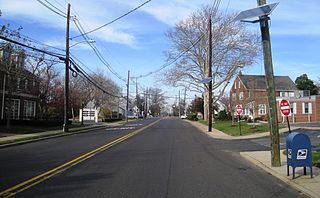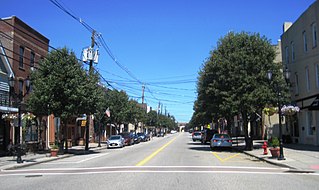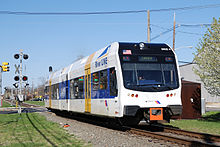
The River Line is a diesel tram-train light rail system in southern New Jersey, United States, that connects the cities of Camden and Trenton, New Jersey's capital. It is operated for New Jersey Transit by the Southern New Jersey Rail Group (SNJRG), which originally included Bechtel Group and Bombardier. Now that the project is in its operational phase, Bombardier is the only member of SNJRG. The River Line is so named because the path between those two cities runs more or less parallel to the Delaware River.

NJ Transit Rail Operations is the rail division of NJ Transit. It operates commuter rail service in New Jersey, with most service centered on transportation to and from New York City, Hoboken, and Newark. NJ Transit also operates rail service in Orange and Rockland counties in New York under contract to Metro-North Railroad. The commuter rail lines had an average weekday ridership of 306,892 from June 1, 2015 to June 30, 2016. This does not include NJ Transit's light rail operations.

The Central Railroad of New Jersey, also known as the Jersey Central or Jersey Central Lines, was a Class I railroad with origins in the 1830s. It filed for bankruptcy three times; in 1939, 1947 and on March 22, 1967, the CNJ filed for bankruptcy for the final time. It foreshadowed the rest of New Jersey's railroads, but not by much. It then pulled out of Pennsylvania completely in 1972. While most of the passenger services, structures and equipment were picked up by the State of New Jersey, later NJ Transit, it was absorbed into Conrail in April 1976 along with several other prominent bankrupt railroads of the northeastern United States. Only two of the railroad's steam locomotives were preserved: CNJ No. 592 & CNJ No. 113; the latter is the only one that is still operational.
Conrail Shared Assets Operations or CSAO is the commonly used name for modern-day Conrail. Conrail is an American railroad company. It operates three networks—the North Jersey, South Jersey/Philadelphia, and Detroit Shared Assets Areas, where it serves as a contract local carrier and switching company for its owners, CSX Transportation and the Norfolk Southern Railway. When most of the former Conrail's track was split between these two railroads, the three shared assets areas were kept separate to avoid giving one railroad an advantage in those areas. The company operates using its own employees and infrastructure, but owns no equipment outside MOW equipment.
The Newark–Trenton Fast Line was an interurban line from Newark, New Jersey to Trenton, New Jersey via Elizabeth and New Brunswick. It was owned and operated by the Public Service Railroad, a subsidiary of the Public Service Corporation of New Jersey.
The United New Jersey Railroad and Canal Company (UNJ&CC) was a railroad company which began as the important Camden & Amboy Railroad (C&A) whose 1830 lineage began as one of the eight or ten earliest permanent North American railroads, and among the first common carrier transportation companies whose prospectus marketed an enterprise aimed at carrying passengers fast and competing with stagecoaches between New York Harbor and Philadelphia-Trenton. Among the other earliest chartered or incorporated railroads, only the Mohawk and Hudson Railroad and Baltimore and Ohio Railroad were chartered with passenger services in mind. Later after mergers as the UNJ&CC became a subsidiary part of the Pennsylvania Railroad (PRR) system in New Jersey by the later merger and acquisition of several predecessor companies in 1872; which purchases also included the PRR's main line to New York City. Prior to 1872, its main lines were the Camden and Amboy Rail Road and Transportation Company, the first railroad in New Jersey and one of the first railroad in the United States.

The Atlantic City Line (ACL) is a commuter rail line operated by NJ Transit (NJT) in the United States between Philadelphia, Pennsylvania and Atlantic City, New Jersey, operating along the corridor of the White Horse Pike. It runs over trackage that was controlled by both the Pennsylvania Railroad (PRR) and the Pennsylvania-Reading Seashore Lines. It shares trackage with SEPTA and Amtrak on the Northeast Corridor (NEC) until it crosses the Delaware River on its own Delair Bridge into New Jersey. The Atlantic City Line also shares the right-of-way with the PATCO Speedline between Haddonfield and Lindenwold, New Jersey. There are 14 departures each day in each direction. Conrail also uses short sections of the line for freight movements, including the NEC-Delair Bridge section to its main freight yard in Camden, New Jersey. Unlike all other NJT railway lines, the Atlantic City line does not have traditional rush hour service. The Atlantic City line is colored dark blue on New Jersey Transit's system maps, and the line's symbol is a lighthouse.

Trenton Transit Center is the main passenger train station in Trenton, New Jersey. It is the southernmost stop in New Jersey on the Northeast Corridor. It is the terminus for NJ Transit trains to and from New York City and SEPTA Trenton Line Regional Rail trains to and from Philadelphia, Pennsylvania, and an intermediate station for Amtrak trains traveling between the two cities along the Northeast Corridor.
The Belvidere Delaware Railroad was a railroad running along the eastern shore of the Delaware River from Trenton, New Jersey north via Phillipsburg, New Jersey to the small village of Manunka Chunk, New Jersey. It became an important feeder line for the Lehigh Valley Railroad's join to the Central Railroad of New Jersey, which was constructed into Phillipsburg, NJ at about the same time. This connected Philadelphia and Trenton, NJ at one end of the shortline railroad to the rapidly growing lower Wyoming Valley region, and via the Morris Canal or the CNJ, a slow or fast connection to New York City ferries crossing New York Harbor from Jersey City, NJ. In 1871 the CNJ leased various railroads in Pennsylvania, most from the Lehigh Coal & Navigation Company allowing the CNJ to penetrate to the upper Wyoming Valley, over some stretches, competing directly with the Lehigh Valley Railroad and with the Lehigh Canal and the trunk road connection of the Belvidere Delaware Railroad to New York became less profitable since Philadelphia connected more easily to Northeastern Pennsylvania thereafter without needing a double-crossing of the Delaware River; a general revenue decline ensued, leading to the Pennsylvania Railroad acquiring the rights, where it served as part of the Pennsylvania Railroad (PRR) system, carrying mainly anthracite coal and iron ore from northeastern Pennsylvania to population centers along the coast.

The Conrail Lehigh Line is a railroad line in New Jersey that is part of Conrail Shared Assets Operations under the North Jersey Shared Assets Area division. The line runs from CP Port Reading Junction in Manville to Oak Island Yard in Newark. The line is double-track and signaled through its entire length. The line began operations in 1999 using former existing tracks from Manville to Newark that was once part of the original Lehigh Line which is still in existence and is owned and operated by Norfolk Southern Railway.

Roebling is a station on the River Line light rail system, located in Roebling, New Jersey. The station opened on March 15, 2004 together with the line. A previous station, operated by the Pennsylvania Railroad, was located at the site from around 1907 until the 1950s. The station consists of one side platform serving the single-track line; an adjacent parking lot originally intended to support nearby developments is used by local commuters.
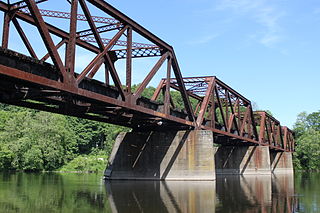
The Lackawanna Old Road was part of the original mainline of the Delaware, Lackawanna & Western Railroad (DL&W). Opened in 1856, it was for a half-century a part of the line connecting the states of New Jersey and Pennsylvania. In 1911, the DL&W cut 11 miles (18 km) off the route by opening the Lackawanna Cut-Off, which branched off from existing track at the new Port Morris Junction and Slateford Junction. The 39.6-mile (63.7 km) stretch of existing track between these junctions was relegated to secondary status and became known as the "Old Road".

The Perth Amboy and Woodbridge Railroad was a railroad operated by the Pennsylvania Railroad (PRR). The main line began along the PRR main at Rahway, New Jersey. The line was only 6 miles (9.7 km) long and was electrified in the year 1935. The line ended at the now closed Essay Tower in South Amboy, New Jersey. The rail line was double tracked and was used for both freight and passenger service. At Essay it would become the New York and Long Branch Railroad which would run to Bay Head Junction. At Essay traffic from the main or the South Amboy engine facility to the holding track outside the station. Essay also controlled traffic on the Camden and Amboy Railroad today known as the Amboy Secondary Track.

The West Jersey and Seashore Railroad (WJ&S) was a Pennsylvania Railroad subsidiary that became part of Pennsylvania-Reading Seashore Lines in 1933. At the end of 1925 it operated 379 miles (610 km) of road on 717 miles (1,154 km) of track; that year it reported 166 million ton-miles of revenue freight and 332 million passenger-miles.

The Glassboro–Camden Line is an 18-mile (28.97 km) diesel multiple unit (DMU) light rail system planned for the southwestern part of New Jersey in the United States. At its northern end in Camden it will connect with the River Line with which its infrastructure and vehicles will be compatible. At the northern terminus, the Walter Rand Transportation Center, paid transfers will be possible to the PATCO Speedline. The route will generally follow the right of way (ROW) of Conrail's South Jersey/Philadelphia Shared Assets Operations Vineland Secondary freight rail line which continues beyond the light rail terminus in Glassboro. The project is part of a greater plan to expand public transportation in the Delaware Valley metro area. It was expected to cost $1.8 billion and be completed in 2019. In July 2014 the Federal Transit Administration said it would not proceed with a required environmental study because no owner or operator has been identified. While the Delaware River Port Authority is overseeing the $8.1 million environmental study, the agency has not agreed to build or run it. New Jersey Transit has agreed to fund the $8.1 million study, but has also not committed to building or running it. As of 2016, there was no funding for the project.
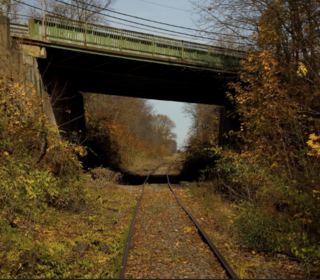
The Salem Branch is a rail freight line in the southwestern part of New Jersey in the United States between the Port of Salem and Woodbury Junction where it and the Penns Grove Secondary converge with the Vineland Secondary approximately 8.5 miles (13.7 km) south of Pavonia Yard in Camden.

The Lehigh Line is a railroad line in central New Jersey and northeastern Pennsylvania. It is owned and operated by the Norfolk Southern Railway. The line runs west from the vicinity of the Port of New York and New Jersey (via Conrail's Lehigh Line to the Susquehanna River valley at the south end of the Wyoming Valley Coal Region. Administratively it is part of Norfolk Southern's Harrisburg Division and is also part of the Crescent Corridor. As of 2016 the line is freight-only, although there are perennial proposals to restore passenger service over all or part of the line.

The Freehold Secondary is a partially active rail line in New Jersey, the active portion of which is owned and operated by Conrail Shared Assets Operations (CSAO). The portion which is in use runs from Jamesburg, NJ, to the current end of service at Freehold, NJ. Technically, the line continues to a junction with the Southern Secondary in Farmingdale, NJ, but this portion has been out of service since the early 2000s.
The Hightstown Industrial Track is a rail line in New Jersey, owned and operated by Conrail Shared Assets Operations (CSAO). The line runs from Jamesburg, New Jersey to the current end of track at Cranbury, New Jersey. The line was built by the Camden & Amboy Railroad (C&A) one of the first railroads in the country. It has been operated by C&A, the Pennsylvania Railroad, Penn Central, and finally, Conrail.



